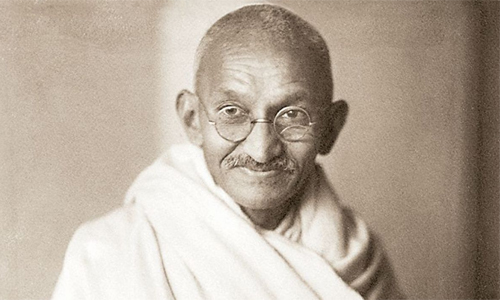Humanity is passing through roads plagued by wars, conflicts, hunger and environmental destruction and loss of natural resources. We must restore the balance between individuals, people and nature before it is too late and non-violence has much to contribute. The ideal of non violent world social order may not be possible in the present state-of-affairs at the global level, but it can be realizable in the future as a result of evolution of human society.
Today marks the 150th birth anniversary of Mahatma Gandhi. The most important contribution of India to the contemporary world is the message of non-violence and global peace. It was formulated and practiced by Mahatma Gandhi. His principles and values faced changing and challenging condition in our days- but they continue to remain unbeaten and march on.
Mahatma Gandhi, the pioneer of non-violence was born on 2nd October 1869. His prominent role in India’s freedom struggle fetched him the title of ‘father of the Nation’. The birthday of this Indian preeminent spiritual and political leader is celebrated as “International Day of Non-Violence” throughout the world.
The transition of the concept of peace from absence of war and violence to a dynamic, positive vision of peace incorporating structural and cultural violence has broadened the scope of peace movements from being focused on single issues to a wide range of issues including human rights, gender equality, democracy, social justice and sustainable development and so on.
The beauty of Gandhi’s values lies in their simplicity and timelessness. He emphasized on the principles of social justice, and his concern about the environment remained relevant even today. The contribution of Gandhi in developing the contemporary perspectives on the concept of peace and non-violence has been acknowledged by well known peace lover people across the world.
Since Non-violence originates from love, compassion, goodwill, cooperation, harmony, and selflessness, a genuine and enduring peace can be ensured only through non-violent means. Non-violence offers us practical means to struggle efficiently against injustice. Gandhi was striving to demolish the prevailing ideology of violence through his speeches and writings. Violence is unable to shape history; it can often only serve to destroy it. In that sense it is indeed violence, and not non-violence, which is utopia. Our challenge is to cultivate the culture of nonviolence.
The Peace conveys the meaning of Peace with justice. Non-violence is no longer passive. It is a radical force. Gandhi believed that human beings are essentially non-violent in their nature. Non-violent means is the only alternative to eradicate the beastly and anti-social tendencies from the human mind, and to elevate human society to a superior plane wherein the entire humanity can live in peace and harmony.
Gandhi, perhaps was the only person who changed the concept of non-violence. Ahimsa, the Indian word for non-violence is commonly understood as doing no harm or injury to other people. But Gandhi visualized it as a radical force. Even during the initial stages he explained the idea of positive non-violence. Gandhi’s theory and practice and provide five interrelated guiding principles for a sustainable world can be described in principles:
Ahimsa: Ahimsa is the greatest force available to humankind. It is mightier than the mightiest weapon of destruction devised by the ingenuity of a man. Gandhi was the first person who applied the concept of non-violence for a political purpose. Gandhi’s greatest contribution, therefore, is the use of non-violence into a successful technique for direct mass action.
Satyagraha: Satyagraha is the most cultured way of bringing desirable social change. Satyagraha campaign might involve the use of multiple non-violent resistance techniques. It is the generic term for nonviolent action. It can take the specific forms of direct action, boycotts, strikes, letter writing, mass protests, prayerful fasting and so on. In all cases it tests the hypothesis that all humans, whatever their differential stakes in hierarchical power structures, share a common core of humanity which can be reached, educated, and liberated by nonviolent and, if necessary, self-sacrificial action.
Sarvodaya: It is the hypothesis that an ecologically-enlightened, tradition-respecting, labor-intensive, decentralized system of village economies with cottage industries can come about by the tireless application of disciplined human intelligence, imagination, and sheer hard work by methods and institutions morally identical to the ends envisioned.
Injustice is the root cause of all national and international conflicts. Inequality breeds exploitation, fear and strife. Peace is possible only among equals. Therefore, the consciousness of equality is an essential requirement to bring about a climate of peace.
The universality of Gandhi’s principles can be utilized as the necessary first step to creating a nonviolent world, since peace begins in our minds and hearts, moral regeneration of individuals and an equitable social order on the other are necessary requirements for achieving global peace.
Home » Opinion » The Gandhian Principles for Non-violence and Peace
The Gandhian Principles for Non-violence and Peace
| Dr. Ahmad Meraj

